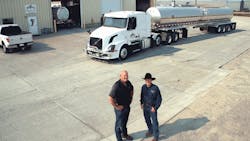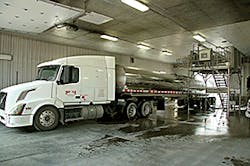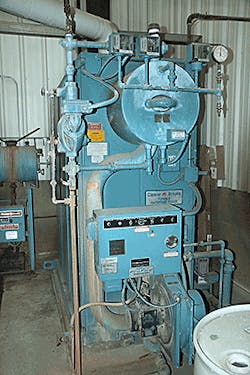Volvo’s new Adaptive Loading system helps boost productivity, safety for Idaho Milk Transport
ALWAYS on the lookout for new ways to improve fleet productivity and vehicle performance, Gene and Robert Brice began researching a high-tech 6x2 system used in Europe by Volvo Trucks. In short order, they became convinced that the system would be an ideal fit for tank truck fleets and other carriers in North America.
Partners and founders of Idaho Milk Transport Inc in Burley, Idaho, the two brothers began their quest in 2012. Volvo Trucks North America officials responded enthusiastically, and the liquid food hauler had its first test truck on the road by 2013. Volvo’s new Adaptive Loading system has now been introduced to the North American market with full production availability coming in 2016.
Thirty-two of the 34 test trucks with the Adaptive Loading system were based in Idaho, and many of them were in the Idaho Milk Transport fleet.
“We saw the benefits of this new 6x2 system almost immediately, and we will never go back to 6x4 configurations,” says Robert Brice. “The Adaptive Loading system reduces tractor tare weight by about 300 pounds, and it definitely has improved fuel economy. We are seeing longer tire life, and it has been impressive on snow and ice during the winter months. We are now encouraging Volvo Trucks to make this system available for our four-axle tractors, as well as the three-axle units.
“We want to maximize fuel economy as much as possible with the variety of equipment we run in our operation. For instance, our four-axle tractors haul four-axle tank trailers. When those rigs are empty, we want just three axles out of eight on the ground. That is our ultimate goal with the Adaptive Loading system.”
Test run
Bulk Transporter magazine had an opportunity in late August to see one of the Idaho Milk Transport test trucks in operation on a run from Salt Lake City, Utah, to Burley. It was an impressive demonstration.
Behind the wheel of the Volvo VNL62T 630 was JW Ray, a veteran Idaho Milk Transport driver who was involved in much of the carrier’s testing of the Adaptive Loading system. The tractor featured a liftable forward axle and Volvo’s Electronically Controlled Suspension (ECS). Adaptive Loading uses ECS to dynamically weight among the two rear axles. In addition, the system—based on pre-programmed weight thresholds—automatically lifts the non-driven axle in empty or light-load situations to create a 4x2 configuration, which reduces rolling resistance from tires. Idaho Milk Transport gets additional rolling resistance reduction by lifting one of the trailer axles during an empty backhaul.
Ray says he was sold on the Adaptive Loading system very quickly and became a true believer in the safety benefits of the system the first time he experienced black ice with the test tractor. “It didn’t just handle the black ice; it made it seem like the ice wasn’t even there,” he said, while pointing out on the dash display how the ECS constantly adjusts drive axle weight to maximize traction.
Founded in 1987, Idaho Milk Transport has been a long-time Volvo customer. “We bought our first Volvo in 1988, and Volvos now account for a majority of the tractors in our operation,” Gene Brice says.
The foodgrade tank truck carrier runs 150 tractors and 250 tank trailers and has 180 employees, most of them drivers. The fleet hauls a wide variety of liquid foods. While milk was the original cargo in 1987, the carrier quickly added liquid sugar, cream, condensed milk, and edible oils. Juices were added around 2000, and the carrier hauls a small amount of wine and whiskey.
“We move a lot of cream and condensed milk to customers in Minnesota and Wisconsin,” Gene Brice says. “Edible oils are backhauls to French fry processors in the west. Milk and milk products account for around 60% of the product we haul.”
Roughly 95% of the operations are conducted in the western United States, but the carrier offers service throughout the United States, Canada, and Mexico. In addition to the headquarters terminal in Burley, operations are conducted out of facilities in Fresno, California, and Yakima, Washington.
In-house foodgrade tank cleaning is performed at the terminals in Burley and Yakima, and the carrier is in the process of adding a single-bay wash rack in Fresno. The largest of the wash racks is at the Burley terminal. The two-bay tank cleaning facility has an in-house-built vat-style system and a 60-horsepower boiler. The Yakima location has a single-bay wash rack equipped with a Peacock single-pass wash system. The Fresno wash rack will be a single bay with a vat-style wash system.
“Our in-house designed and built wash system in Burley can clean out most of the foodgrade products we handle in about 45 minutes,” Gene Brice says. “We use a spray ball wash system that is typical for foodgrade cleaning, and many of our trailers have clean-in-place capabilities.”
Idaho Milk Transport uses TMW Suite for fleet management, and most of the dispatch activity occurs at the headquarters terminal. However, the Fresno terminal coordinates milk shipments within California. Operations include a mix of local, regional, and longhaul activities. Longhaul drivers typically are out two to six weeks at a time.
Adequate supply
With the mix of business, the carrier has been largely successful in finding enough drivers to keep all of the tractors in the fleet on the road. “We’re in a good position on drivers right now,” Gene Brice says. “Stable local business is one factor, with many of our drivers working a predictable five to six days a week. Not surprisingly, the longhaul trucks have been the hardest to keep manned.”
On the positive side, the carrier is attracting quite a few younger drivers. However, many of the applicants come in with little or no truck driving experience, and they require a lot of training to become good, productive truck drivers.
“That’s not a problem,” Gene Brice says. “We’re more than willing to train them from the ground up. We’re looking for someone with a desire to be a truck driver and a good work ethic. We start many of these potential drivers in the wash rack and move them to local driving and beyond as their driving skills develop.”
Drivers must be at least 21 years old to work for Idaho Milk Transport. Initial training lasts about 30 days, and newly hired drivers usually stay within 150 miles of the terminal during that time.
Drivers learn how to handle the various foodgrade cargoes and how to operate the equipment. “We make sure they understand what it takes to transport liquid bulk food products safely and securely,” Gene Brice says. “We also make sure they understand the technology in our tractors and what that means for safe, productive operations.”
Tech focus
Tractor technology includes Omnitracs on-board computers that are tied in with the TMW fleet management system. Driver vehicle inspection reports are processed through the carrier’s TMT maintenance software.
“We’re in the process of moving to electronic driver logs,” Robert Brice says. “We’ve already made that move in our longer haul operations, and we should have the local operations on board by the end of the year.”
One of the most notable technology devices drivers see when they climb into the cab of an Idaho Milk Transport tractor for the first time is the Drive Cam in-cab digital video system. “We began installing these devices two years ago on the recommendation of our insurance company,” Gene Brice says. “Specifically, the system captures hard braking, accident, crash, and stability events. It will even capture events such as other trucks hitting our parked vehicle in a parking lot. We use our on-board systems to recognize our best drivers, as well as to identify drivers who need additional training.”
The latest Volvo tractors in the fleet also come with plenty of built-in technology to enhance driver productivity. This certainly includes the Adaptive Loading system, which is getting a very good reception from drivers.
The newest tractors were specified with Volvo’s D13 engine rated at 405 horsepower and Volvo’s 12-speed overdrive I-Shift automated transmission. Drive axles are from Meritor. Tractors also have Alcoa aluminum disc wheels and Michelin tires.
“Combining the Volvo drivetrain with the new 6x2 Adaptive Loading system is delivering fuel economy of 9.64 to 9.65 miles per gallon,” Robert Brice says. “While this is very good, we are confident that 10 mpg is possible with this system.”
Gene Brice adds: “We believe Volvo hit a homerun with the I-Shift transmission. We tell our drivers to just put the truck in drive and let the transmission do the work to get the best fuel mileage.”
On the 6x2 units, a non-driven lift axle from Hendrickson is paired with the drive axle. The carrier also runs three- and four-axle tractors with Link non-driven lift axles.
Tank trailers
Idaho Milk Transport runs a variety of stainless steel foodgrade tank trailers manufactured by Walker Stainless, Brenner Tank, and West-Mark Inc. Tank hardware includes Olsen vents in the domelids, and most of the trailers in the fleet have clean-in-place capabilities.
Tanks are constructed of Type 304 stainless steel, and are insulated with a combination of fiberglass and hard foam that limits temperature gain to less than one degree per day. The fleet saves weight by specing trailers without product pumps. “We don’t need pumps on our trailers because our customers have pumps at their facilities,” Gene Brice says.
The carrier runs a variety of trailer configurations that are allowed in most western states. Tandem-axle trailers have capacities ranging from 6,250 to 7,000 gallons. Four-axle tankers can hold 8,400 gallons. Rocky Mountain doubles combinations have a total capacity of 9,200 gallons.
All of this gives Idaho Milk Transport a very efficient and productive fleet, and the addition of the Adaptive Loading system will help make the fleet even better. ♦
About the Author
Charles Wilson
Charles E. Wilson spent 31 years covering the tank truck, tank container, and storage terminal industries throughout North, South, and Central America as the editor of Bulk Transporter. Prior to 1989, Wilson was managing editor of Bulk Transporter and Refrigerated Transporter and associate editor of Trailer/Body Builders. Before joining the three publications in Houston TX, he wrote for various food industry trade publications in other parts of the country. Wilson has a bachelor's degree in journalism from the University of Kansas and served three years in the U.S. Army.




